Our sister blog @thinkingtravelerproject has just launched a brand new travel diary/mini blog online platform,Theem8.com. If this is something that you are interested in, then please visit the site, otherwise just enjoy all the cool science.
Don't wanna be here? Send us removal request.
Photo
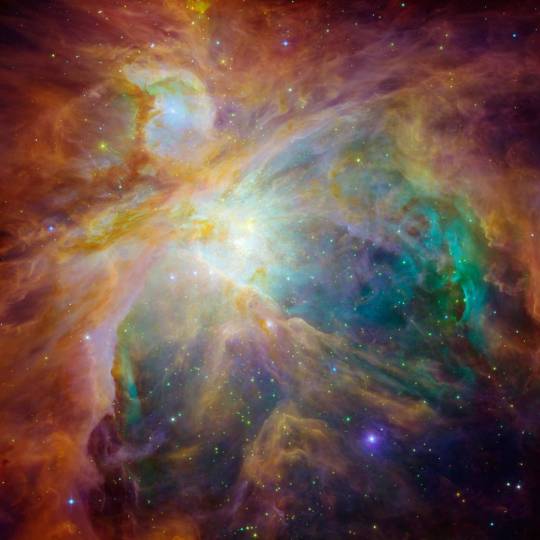
“Gaseous swirls of hydrogen, sulfur, and hydrocarbons cradle a collection of infant stars in this composite image of the Orion Nebula, as seen by the Hubble Space Telescope and the Spitzer Space telescope. Together, the two telescopes expose carbon-rich molecules in the cosmic cloud of this star-formation factory located 1,500 light-years away.
Hubble's ultraviolet and visible-light view reveal hydrogen and sulfur gas that have been heated and ionized by intense ultraviolet radiation from the massive stars, collectively known as the "Trapezium." Meanwhile, Spitzer's infrared view exposes carbon-rich molecules in the cloud. Together, the telescopes expose the stars in Orion as a rainbow of dots sprinkled throughout the image.”
Credit: NASA/JPL-Caltech STScI
90 notes
·
View notes
Photo
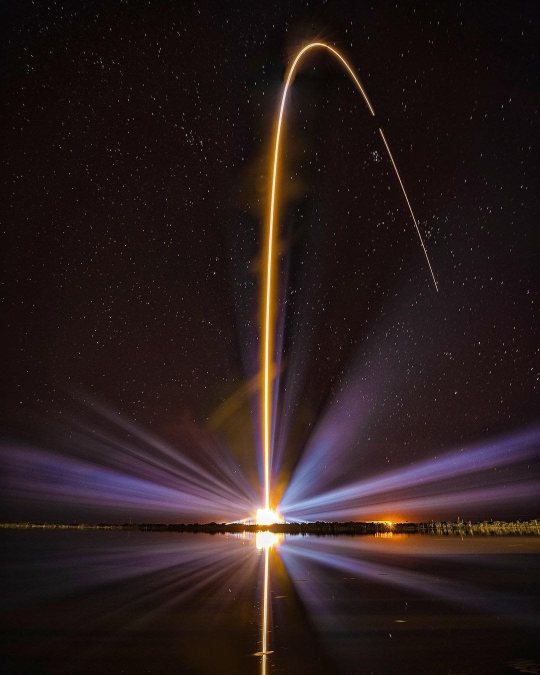
Delta IV Heavy (Delta 9250H) Launch.
Credit: Alex G Perez
216 notes
·
View notes
Photo

Jovian ‘Twilight Zone'
‘This image captures the swirling cloud formations around the south pole of Jupiter, looking up toward the equatorial region.
NASA’s Juno spacecraft took the color-enhanced image during its eleventh close flyby of the gas giant planet on Feb. 7 2018 at 7:11 a.m. PST (10:11 a.m. EST). At the time, the spacecraft was 74,896 miles (120,533 kilometers) from the tops of Jupiter’s clouds at 84.9 degrees south latitude.‘
Source: NASA/JPL-Caltech/SwRI/MSSS/Gerald Eichstädt
165 notes
·
View notes
Photo

Prince Rupert’s Drop
“ Prince Rupert's drops (also known as Dutch or Batavian tears)[are toughened glass beads created by dripping molten glass into cold water, which causes it to solidify into a tadpole-shaped droplet with a long, thin tail. These droplets are characterized internally by very high residual stresses, which give rise to counter-intuitive properties, such as the ability to withstand a blow from a hammer or a bullet on the bulbous end without breaking, while exhibiting explosive disintegration if the tail end is even slightly damaged. In nature, similar structures are produced under certain conditions in volcanic lava, and are known as Pele's tears. “
Source: Wikipedia
133 notes
·
View notes
Video
tumblr
Ultra Slow Motion match lighting.
158 notes
·
View notes
Photo

A view of the Sun from the Extreme ultraviolet Imaging Telescope on ESA/NASA's Solar and Heliospheric Observatory, or SOHO. Launched on December 2, 1995, SOHO has spent a quarter century in space.
Credits: ESA/NASA
79 notes
·
View notes
Photo
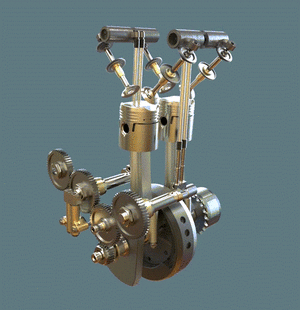
319 notes
·
View notes
Photo

“Hubble was recently retrained on NGC 6302, known as the "Butterfly Nebula," to observe it across a more complete spectrum of light, from near-ultraviolet to near-infrared, helping researchers better understand the mechanics at work in its technicolor "wings" of gas. The observations highlight a new pattern of near-infrared emission from singly ionized iron, which traces an S shape from lower left to upper right. This iron emission likely traces the central star system’s most recent ejections of gas, which are moving at much faster speeds than the previously expelled mass.
The star or stars at its center are responsible for the nebula's appearance. In their death throes, they have cast off layers of gas periodically over the past couple thousand years. The "wings" of NGC 6302 are regions of gas heated to more than 36,000 degrees Fahrenheit that are tearing across space at more than 600,000 miles an hour.
NGC 6302 lies between 2,500 and 3,800 light-years away in the constellation Scorpius.”
Source: NASA, ESA, and J. Kastner (RIT)
82 notes
·
View notes
Video
tumblr
Lightning - Ultra Slow Motion
169 notes
·
View notes
Photo
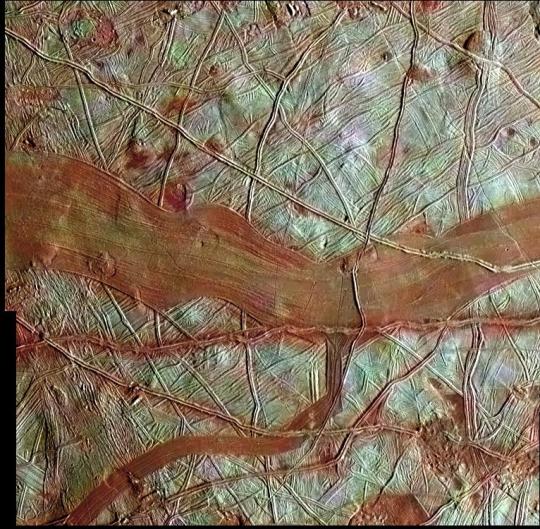
Reddish Bands on Europa
“This colorized image of Europa is a product of clear-filter grayscale data from one orbit of NASA's Galileo spacecraft, combined with lower-resolution color data taken on a different orbit.
The blue-white terrains indicate relatively pure water ice, whereas the reddish areas contain water ice mixed with hydrated salts, potentially magnesium sulfate or sulfuric acid. The reddish material is associated with the broad band in the center of the image, as well as some of the narrower bands, ridges, and disrupted chaos-type features. It is possible that these surface features may have communicated with a global subsurface ocean layer during or after their formation. “
Source: NASA/JPL-Caltech/SETI Institute
38 notes
·
View notes
Photo

“Titan, Saturn's largest moon, measures 3,200 miles, or 5,150 kilometers, across and is larger than the planet Mercury.
As the seasons have changed in the Saturnian system, and spring has come to the north and autumn to the south, the azure blue in the northern Saturnian hemisphere that greeted Cassini upon its arrival in 2004 is now fading. The southern hemisphere, in its approach to winter, is taking on a bluish hue. This change is likely due to the reduced intensity of ultraviolet light and the haze it produces in the hemisphere approaching winter, and the increasing intensity of ultraviolet light and haze production in the hemisphere approaching summer. (The presence of the ring shadow in the winter hemisphere enhances this effect.)
This view looks toward the northern, sunlit side of the rings from just above the ring plane. This mosaic combines six images -- two each of red, green and blue spectral filters -- to create this natural color view. The images were obtained with the Cassini spacecraft wide-angle camera on May 6, 2012, at a distance of approximately 483,000 miles (778,000 kilometers) from Titan. Image scale is 29 miles (46 kilometers) per pixel on Titan.”
NASA/JPL-Caltech/Space Science Institute
72 notes
·
View notes
Video
tumblr
92 notes
·
View notes
Photo
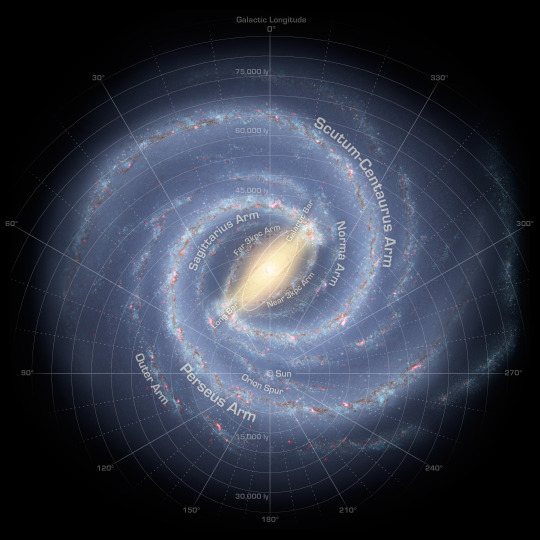
Millky Way
“Like early explorers mapping the continents of our globe, astronomers are busy charting the spiral structure of our galaxy, the Milky Way. Using infrared images from NASA's Spitzer Space Telescope, scientists have discovered that the Milky Way's elegant spiral structure is dominated by just two arms wrapping off the ends of a central bar of stars. Previously, our galaxy was thought to possess four major arms.
The annotated artist's concept illustrates the new view of the Milky Way. The galaxy's two major arms (Scutum-Centaurus and Perseus) can be seen attached to the ends of a thick central bar, while the two now-demoted minor arms (Norma and Sagittarius) are less distinct and located between the major arms.”
Source: NASA/JPL-Caltech/R. Hurt (SSC/Caltech)
93 notes
·
View notes
Video
tumblr
SUN - From Hot to Hottest
“ This sequence of images shows the Sun from its surface to its upper atmosphere all taken at about the same time (Oct. 27, 2017). The first shows the surface of the Sun in filtered white light; the other seven images were taken in different wavelengths of extreme ultraviolet light. Note that each wavelength reveals somewhat different features. They are shown in order of temperature from the first one at 6,000 degrees C (about 10,800 degrees F) on the surface out to about 10 million degrees C (18 million degrees F) in the upper atmosphere. Yes, the Sun's outer atmosphere is much, much hotter than the surface. Scientists are getting closer to solving the processes that generate this phenomenon. “
Source: NASA/GSFC/Solar Dynamics Observatory
44 notes
·
View notes
Photo



Beautiful engineering designs - Gareth Fowler
@garethwashere
895 notes
·
View notes
Photo

“ Cyclones at the north pole of Jupiter appear as swirls of striking colors in this extreme false color rendering of an image from NASA's Juno mission. The huge, persistent cyclone found at Jupiter's north pole is visible at the center of the image, encircled by smaller cyclones that range in size from 2,500 to 2,900 miles (4,000 to 4,600 kilometers). Together, this pattern of storms covers an area that would dwarf the Earth. “
“ Citizen scientist Gerald Eichstädt made this composite image using data obtained by the JunoCam instrument during four of the Juno spacecraft's close passes by Jupiter, which took place between Feb. 17, 2020 and July 25, 2020. The greatly exaggerated color is partially a result of combining many individual images to create this view. “
NASA JPL
55 notes
·
View notes
